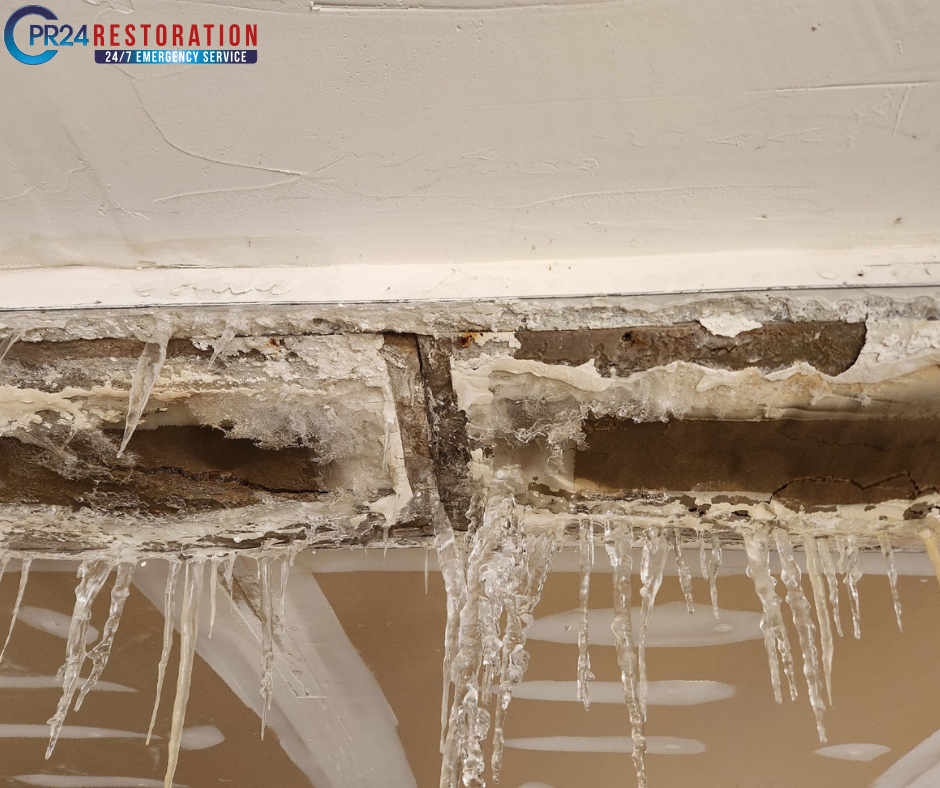The cold winter temperatures in Toronto can cause significant issues for home plumbing systems. Frozen pipes are a common and serious issue. When water freezes inside pipes, it expands and puts immense pressure on the plumbing, often leading to cracks, leaks, or full-blown bursts.
The resulting water damage can be extensive and costly if not addressed swiftly and properly. This guide will help you deal with frozen pipes in Toronto. It covers how to find the problem and how to prevent it in the future.
As temperatures plummet in the Greater Toronto Area, homeowners must remain vigilant about their plumbing. Knowing how to respond quickly to frozen pipes can make a significant impact.
It can turn a small problem into a major disaster for your home. Let’s discuss the key steps to take. We will also look at the services available for Toronto residents dealing with plumbing problems in the cold.
Identifying Frozen Pipes
Before you can address the issue of frozen pipes, you need to be able to recognize the signs. Early detection is key to preventing extensive water damage to your home and costly water damage repairs. Here are some telltale indicators that your pipes may be frozen:
Visible Frost on Pipes
In parts of your home where pipes are visible, like basements, crawl spaces, or under sinks, you may see frost on the outside of the pipe. This is a clear sign that the water inside has frozen and immediate action is necessary.
No Water Flow
Turn on your faucets. If little or no water comes out, or if the flow is much lower, ice may be blocking the pipe. This can occur in both hot and cold water lines.
Strange Odours
When pipes freeze, the blockage can cause odours to back up into your home through the drain. If you notice unusual smells coming from your faucets or drains, it could indicate a frozen pipe.
Unusual Sounds
As water freezes and expands in the pipes, it can create pressure that leads to creaking or banging noises. If you hear these sounds coming from your walls or floors, it may be a sign of freezing pipes.
Bulging Pipes
In some cases, the pressure from frozen water can cause pipes to bulge or swell. This is often a precursor to a pipe burst and requires immediate attention.
By being aware of these signs, you can catch frozen pipes early and act before they cause significant damage to your Toronto home.
Immediate Steps to Take
When you suspect or confirm that you have frozen pipes, time is of the essence. Taking swift action can prevent further damage and potentially save you from costly repairs. Here’s what you should do immediately:
Shut Off the Main Water Supply
Locate your home’s main water shut-off valve and turn off the water. You can typically find this valve in the basement or crawl space, near where the main water line enters your home. By shutting off the water, you reduce the risk of flooding if a pipe bursts.
Open Faucets
After turning off the main water supply, open all faucets in your home. This relieves pressure in the system and allows water to drain from the pipes as they thaw. Be sure to open both hot and cold taps.
Begin Gentle Thawing
Start thawing the frozen section of the pipe if you can access it safely. Use gentle heat sources such as a hairdryer, heating pad, or towels soaked in warm water. Never use open flame or high-heat devices, as these can damage pipes or create a fire hazard.
Inspect for Leaks
As the pipes begin to thaw, carefully inspect them and surrounding areas for any signs of leakage. Water stains, dripping, or pooling water are indicators of a leak that needs immediate attention.
Document the Damage
If you notice any water damage, take photos and videos for insurance purposes. This documentation can be crucial when filing a claim or seeking professional repairs.
Call a Professional Plumber
While you may be tempted to handle the situation yourself, it’s often best to call a licensed plumber in Toronto. They have the expertise and equipment to safely thaw pipes and repair any damage without causing further issues.
Taking these immediate steps can help mitigate the damage caused by frozen pipes and set the stage for effective repairs. Remember, the goal is to address the issue quickly while ensuring the safety of your home and family.
Thawing Frozen Pipes Safely
Once you’ve taken the immediate steps to secure your home, you can begin the process of thawing frozen pipes. You must do this carefully to avoid causing further damage. Here’s a step-by-step guide to safely thaw your frozen pipes:
Identify the Frozen Section
Before you start thawing, try to locate the exact area where the pipe is frozen. This is often the coldest section of the pipe or the area nearest to an outside wall. Frozen pipes may have frost on the outside or feel colder to the touch than surrounding pipes.
Apply Heat Gradually
Start applying heat to the frozen section of the pipe. Use one of these safe methods:
- An electric heating pad wrapped around the pipe
- Hair dryer aimed at the frozen area
- A portable space heater placed near the pipe (keep away from flammable materials)
- Hot towels wrapped around the pipe
Always start from the end closest to the faucet and work your way towards the colder areas. This allows water to flow out as the ice melts.
Continue Heating
Keep applying heat until full water pressure is restored. This process can take anywhere from 30 minutes to several hours, depending on the severity of the freeze.
Check Other Pipes
Once you’ve thawed one section, check all other faucets in your home to ensure no other pipes are frozen. Frozen pipes often occur in multiple locations, especially during severe cold snaps in Toronto.
Avoid Dangerous Methods
Never use an open flame device like a blowtorch, kerosene or propane heater, or charcoal stove to thaw pipes. These methods can damage pipes or start a fire. Also, avoid using electrical devices in areas of standing water to prevent electric shocks.
Monitor the Process
As you thaw the pipes, keep a close eye on the process. If you notice any leaks, stop thawing immediately and call a professional plumber. Leaks indicate that the pipe has already burst and will need repair or replacement.
Increase Room Temperature
If frozen pipes are inside walls, you can try to thaw them by increasing the temperature in your home. Turn up the thermostat and open cabinet doors to allow warm air to circulate the plumbing.
By using these safe thawing methods, you can often fix small freeze-ups. This helps prevent extra damage to your plumbing system. If you are unsure about any step or face problems, it is best to talk to a professional plumber in Toronto.
Preventing Future Pipe Freezes
After dealing with a frozen pipe incident, it’s crucial to take steps to prevent future occurrences. Toronto’s winters can be harsh, but with proper precautions, you can significantly reduce the risk of frozen pipes. Here are some effective preventive measures:
Insulate Vulnerable Pipes
One of the most effective ways to prevent pipes from freezing is to insulate them properly. Focus on pipes in unheated areas such as:
- Basements
- Attics
- Crawl spaces
- Garages
- Exterior walls
Use foam pipe insulation or heat tape to wrap exposed pipes. This extra layer of protection helps maintain the temperature of the water inside the pipes above freezing point.
Seal Air Leaks
Cold air can enter your home through small cracks and openings, potentially freezing nearby pipes. Inspect your home for air leaks, especially around:
- Windows and doors
- Electrical wiring
- Dryer vents
- Pipes
Use caulk or insulation to seal these gaps and keep cold air out.
Maintain Consistent Indoor Temperature
During cold spells, maintain a consistent temperature in your home, even when you’re away. It might be tempting to lower the thermostat to save money. However, keeping it at a steady temperature of at least 55°F or 13°C can help prevent pipes from freezing.
Allow Faucets to Drip
When temperatures drop significantly, allow faucets to drip slightly. Running water, even at a trickle, is less likely to freeze. This is particularly important for faucets served by exposed pipes.
Open Cabinet Doors
Open kitchen and bathroom cabinet doors to allow warm air to circulate the plumbing. This is especially useful for pipes located against exterior walls.
Disconnect Outdoor Hoses
Before winter sets in, disconnect garden hoses and drain outdoor pipes. Use shut-off valves to stop water flow to outdoor faucets. Also, think about using properly insulated covers for outdoor spigots.
Consider Heat Cables
For particularly vulnerable pipes, consider installing heat cables. You can wrap these electric cables around pipes to provide consistent warmth during cold periods.
Regular Plumbing Inspections
Schedule annual plumbing inspections with a Toronto professional. They can identify potential problem areas and suggest improvements to your home’s plumbing system to prevent freezing.
Educate Household Members
Make sure everyone in your home knows where the main water shut-off valve is. They should also know how to use it in an emergency. Also, teach them to recognize signs of frozen pipes.
Prepare for Absences
If you plan to be away from home during cold weather:
- Set your thermostat to a temperature of at least 55°F (13°C)
- Ask a friend or neighbour to check on your home regularly
- Consider shutting off the water supply lines and draining the system if you’ll be gone for an extended period
By using these preventive measures, you can greatly lower the chance of frozen pipes in your Toronto home this winter. Remember, prevention is always less costly and less stressful than dealing with the aftermath of frozen and burst pipes.
Water Damage from Frozen Pipes
When pipes freeze and burst, the resulting water damage can be extensive and costly. Understanding the potential consequences of frozen pipes can underscore the importance of prevention and prompt action. Here’s an overview of the water damage that can result from frozen pipes in Toronto homes:
Immediate Damage
The moment a pipe bursts, water can begin to flood the surrounding area. This immediate damage can affect:
- Flooring: Carpets, hardwood, and laminates can absorb water, leading to warping, staining, and mold growth.
- Walls and Ceilings: Drywall and plaster can become saturated, leading to sagging, crumbling, and potential collapse.
- Electrical Systems: Water can short-circuit electrical components, posing fire risks and involving rewiring.
- Furniture and belongings can soak when water flows over them. This may ruin them or need a lot of repairs.
Long-Term Consequences
If not addressed promptly and thoroughly, water damage from burst pipes can lead to:
- Structural Damage: Prolonged exposure to water can weaken the structural integrity of your home, affecting beams, joists, and foundations.
- Mold and mildew grow well in damp places. They can start growing within 24 to 48 hours after water exposure.
- Health Risks: Mold growth can lead to respiratory issues and other health problems for occupants.
- Decreased Property Value: Significant water damage, if not properly remediated, can lower your home’s value.
Hidden Damage
Some water damage may not be immediately visible:
- Water can seep into wall cavities, under floorboards, and into insulation.
- This hidden moisture can cause ongoing problems like wood rot and persistent mold growth.
- It may also attract pests that thrive in damp environments.
Assessing Water Damage
After a pipe burst, it’s crucial to assess the full extent of the damage:
- Visible Inspection: Look for water stains, bulging walls or ceilings, and soggy carpets or flooring.
- Moisture Detection: Professional water damage restoration services use specialized equipment to detect moisture in hidden areas.
- Mold Testing: If the water has been present for more than a day, mold testing may be necessary.
Professional Restoration
For significant water damage, professional restoration services are often necessary. These services typically include:
- Water Extraction: Removing standing water and excess moisture from the affected areas.
- Drying and Dehumidification: Using industrial-grade equipment to thoroughly dry the space.
- Cleaning and Sanitizing: Preventing mold growth and addressing any contamination.
- Restoration: Repairing or replacing damaged materials and structures.
Insurance Considerations
When dealing with water damage from frozen pipes:
- Document everything with photos and videos for insurance claims.
- Contact your insurance provider promptly to understand your coverage and next steps.
- Keep receipts for any emergency repairs or temporary adjustments.
Understanding the potential extent of water damage from frozen pipes emphasizes the importance of prevention and quick action. Toronto homeowners should be ready to act quickly if they see a frozen or burst pipe. This helps reduce damage and protect their property.
The Role of Professional Water Damage Restoration
When frozen pipes lead to significant water damage in your Toronto home, professional water damage restoration services become crucial. These experts have the skills, experience, and tools to restore your property quickly and effectively. This helps reduce long-term damage and health risks. Here’s an overview of the role professional restoration services play:
Rapid Response
Professional restoration companies in Toronto often offer 24/7 emergency services. Quick response is critical because:
- It limits the extent of water damage
- It reduces the risk of mold growth
- It can save more of your belongings from permanent damage
Comprehensive Assessment
Restoration professionals conduct a thorough assessment of the damage:
- Visual Inspection: Identifying visible water damage and potential hidden issues
- Moisture Detection: Using specialized equipment to locate moisture in walls, floors, and ceilings
- Damage Types: This involves sorting water damage by the type of water. Three types exist: clean, grey, and black. We also consider the materials that affect us.
Water Removal and Drying
Professional-grade equipment is used for efficient water removal and drying:
- Powerful pumps and vacuums for water extraction
- Industrial-strength dehumidifiers to remove moisture from the air
- High-velocity air movers to accelerate evaporation
Cleaning and Sanitizing
Restoration services include thorough cleaning and disinfection:
- Antimicrobial treatments to prevent mold growth
- Disinfection to eliminate odours caused by water damage
- Cleaning and sanitizing of salvageable items and structures
Restoration and Repairs
Professional services often include restoration of damaged areas:
- Drywall repair or replacement
- Flooring restoration or installation
- Painting and finishing work
- Structural repairs as needed
Documentation and Insurance Assistance
Professional restoration companies can assist with insurance claims:
- Providing detailed documentation of the damage and restoration process
- Offering expert assessments for insurance purposes
- Communicating directly with insurance adjusters when necessary
Advanced Technology
Restoration professionals use state-of-the-art technology:
- Thermal imaging cameras to detect hidden moisture
- Moisture meters to measure the moisture content of materials
- HEPA air filtration devices to improve air quality during restoration
Health and Safety Considerations
Professional restoration services prioritize health and safety:
- Proper handling and disposal of contaminated materials
- Use of personal protective equipment (PPE) during restoration
- Ensuring the restored area is safe for occupancy
Long-Term Solutions
Beyond immediate restoration, professionals can offer advice on preventing future issues:
- Recommendations for improved insulation or pipe protection
- Suggestions for upgrades to your plumbing system
- Tips for ongoing maintenance to prevent future water damage
By hiring professional water damage restoration services, homeowners in Toronto can handle the problems caused by frozen pipes effectively. These experts fix the immediate damage and help stop long-term problems. This protects both your home and your health.



